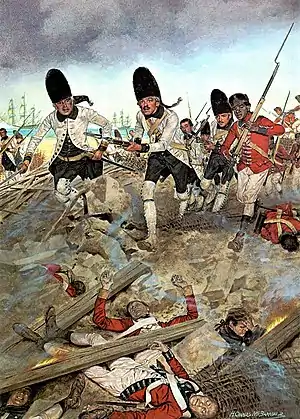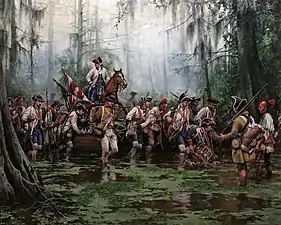Gulf Coast campaign
The Gulf Coast campaign or the Spanish conquest of West Florida in the American Revolutionary War, was a series of military operations primarily directed by the governor of Spanish Louisiana, Bernardo de Gálvez against the British province of West Florida. Begun with operations against British positions on the Mississippi River shortly after Britain and Spain went to war in 1779, Gálvez completed the conquest of West Florida in 1781 with the successful siege of Pensacola.
| Gulf Coast campaign | |||||||
|---|---|---|---|---|---|---|---|
| Part of the American Revolutionary War | |||||||
 Spanish Army captures Fort George during the Siege of Pensacola. Oil on canvas, United States Army Center of Military History. | |||||||
| |||||||
| Belligerents | |||||||
|
|
Choctaw Creek | ||||||
| Commanders and leaders | |||||||
|
|
| ||||||
| Casualties and losses | |||||||
|
220 killed 151 wounded 117 captured 3 sloops captured |
133-180+ killed 228+ wounded 1,797+ captured | ||||||
Background
Spain officially entered the American Revolutionary War on 8 May 1779, with a formal declaration of war by King Charles III. This declaration was followed by another on 8 July that authorised his colonial subjects to engage in hostilities against the British.[1] When Bernardo de Gálvez, the colonial Governor of Spanish Louisiana received word of this on 21 July, he immediately began to secretly plan offensive operations. Gálvez, who had been planning for the possibility of war since April, intercepted communications from the British at Pensacola indicating that the British were planning a surprise attack on New Orleans; he decided to launch his own attack first.[2] To that end, he concealed from the public his receipt of the second proclamation.[3]
Control of the lower Mississippi

On 27 August Gálvez set out by land toward Baton Rouge, leading a force that consisted of 520 regulars, of whom about two-thirds were recent recruits, 60 militiamen, 80 free blacks and mulattoes, and ten Anglo-American volunteers headed by Oliver Pollock.[4] As they marched upriver, the force grew by another 600 men, including Indians and Acadians. At its peak, the force numbered over 1,400; this number was reduced due to the hardships of the march, by several hundred, before they reached Fort Bute.[5]
At dawn on 7 September this force attacked Fort Bute, a decaying relic of the French and Indian War that was defended by a token force.[6] After a brief skirmish in which one German was killed, most of the garrison surrendered.[5] The six who escaped capture made their way to Baton Rouge to notify the British troops there of the fort's capture.[7]
After a few days' rest, Gálvez advanced on Baton Rouge, only 15 miles (24 km) from Fort Bute.[6] When Gálvez arrived at Baton Rouge on 12 September, he found Fort New Richmond garrisoned by over 400 regular army troops and 150 militia, under the overall command of Lt. Colonel Alexander Dickson.[8] After nine days' siege, Dickson surrendered.
Gálvez demanded and was granted terms that included the capitulation of the 80 regular infantry at Fort Panmure (modern Natchez, Mississippi), a well-fortified position which would have been difficult for Gálvez to take militarily. Dickson surrendered 375 regular troops the next day; Gálvez had Dickson's militia disarmed and sent home. Gálvez then sent a detachment of 50 men to take control of Panmure.[9] He dismissed his own militia companies, left a sizable garrison at Baton Rouge, and returned to New Orleans with about 50 men.
Mobile
In early 1780 Gálvez embarked on an expedition to capture Mobile, which was one of only two major British military establishments left in West Florida, the other being the capital, Pensacola. Assembling 750 men at New Orleans, he sailed for Mobile on 11 January, reaching Mobile Bay on 9 February after being delayed by storms. He was joined on 20 February by a supporting force of 450 from Havana, but did not begin siege operations until the 1 March. After 14 days of bombardment, Fort Charlotte's walls were breached, and its commander, Captain Elias Durnford, surrendered.
Gálvez in the fall of 1780 sought to capture Pensacola, launching his naval force from Mobile, but the fleet was dispersed by a major hurricane. Its tattered remnants made their way back to either Havana or New Orleans, and planning began again for an expedition in 1781.
British authorities in Pensacola had, when war with Spain was imminent, attempted to shore up West Florida's defences, but the meagre resources allocated to the region meant that General John Campbell, the military commander at Pensacola, had been able to do little to stop Gálvez's advance. By late 1780 he had received some reinforcements, and managed to recruit a significant force of local Indians to bolster Pensacola's defences. The destruction of Gálvez's expedition emboldened him to attempt the recapture of Mobile. In January 1781 he dispatched more than 700 men under the command of the Waldecker Captain Johann von Hanxleden to go overland. This force was defeated when it attacked one of the forward Spanish defenses of Mobile, and Captain Hanxleden was killed. The attack prompted Spanish authorities in Cuba to enlarge the Mobile garrison.
Pensacola
Gálvez and Spanish authorities in Cuba again launched an expedition against Pensacola in February 1781. With forces that eventually numbered about 8,000, Gálvez, assisted by Spanish and French naval forces, first blockaded the Pensacola harbour, and then began siege operations on 9 March. By the 30 April the Spanish had successfully placed cannons that could fully attack the main Pensacola defences. A lucky cannon shot hit the powder magazine in one of the outer defences on 8 May, and the Spanish quickly capitalised upon this development by capturing the British position. Realising his position was no longer tenable, Campbell opened surrender negotiations the next day. The terms of capitulation included all of the British West Florida.
References
- Gayarré (1867), p. 121
- Gayarré (1867), p. 122
- Gayarré (1867), p. 124
- Gayarré (1867), pp. 125–126
- Gayarré (1867), p. 126
- Haarmann (1960), p. 111
- Nester (2004), p. 232
- Haarmann (1960), p. 112
- Gayarré (1867), p. 129
Bibliography
- Gayarré, Charles (1867). History of Louisiana : The Spanish domination, Volume 3. New York: Widdleton. OCLC 1855106.
- Haarmann, Albert (October 1960). "The Spanish Conquest of British West Florida, 1779–1781". The Florida Historical Quarterly (Volume 39, No. 2). JSTOR 30150253.
- Nester, William R (2004). The Frontier War for American Independence. Mechanicsburg, PA: Stackpole Books. ISBN 978-0-8117-0077-1. OCLC 52963301.